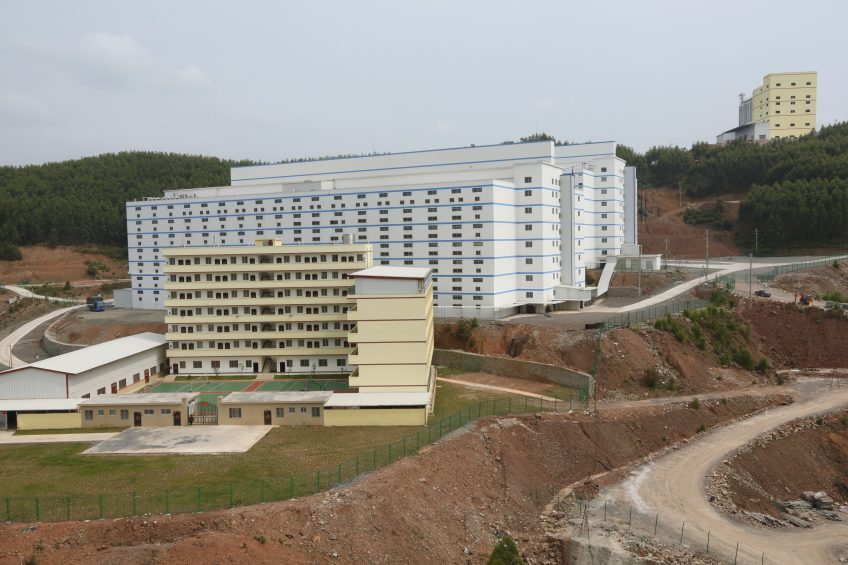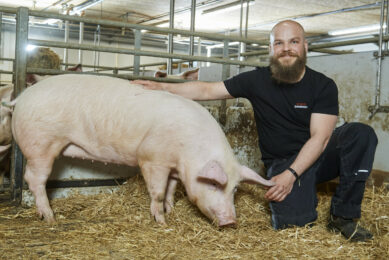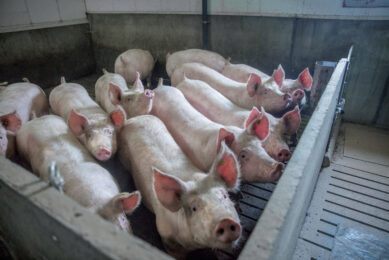The future of swine breeding

This month, Pig Progress featured a great farm visit on a 9-level pig breeding facility in China. Pig Progress editor Vincent ter Beek writes that it is quite unlike anything else in the world, yet at the same time the concept evokes mixed feelings with many readers. Why is that?
What will the future of swine breeding be? That question was asked to 4 panel members at last week’s International Technical Meeting of swine reproduction specialists Magapor, in Zaragoza, Spain.
In 2 of the 4 following pitches, the 400 delegates were shown the picture below.
Impressive pig farm feature in Guigang
Proudly I can say it was taken from a very recent feature published by Pig Progress. In March, my colleague Kees van Dooren travelled to Guigang in southern China, to visit a farm which has sow houses with 7 storeys and also with 9 storeys, housing 1,000 sows per floor. He realised, I realised, our readers online realised and so did the speakers at the Magapor conference that here, global swine production had just touched new ground.
How new exactly?
Multi-storey pig farm in Germany
It’s not that keeping pigs on floors on top of each other has never been done before. In Eastern Germany (before the fall of communism in 1990), smaller-size multi-storey pig buildings were built, like the one below from 1969, for a total of 500 sows.

Multi-storey pig buildings in the Netherlands
Multi-storey buildings also exist in the Netherlands, like the one below here which I visited myself some years ago. Truth be told, this farm has ‘only’ 2 floors and has been neatly camouflaged in the surrounding countryside, so one hardly realises these pigs are kept on 2 floors.

What I remembered of that farm visit, was the same kind of excitement of going into a Boeing 747 jumbo jet for the first time. Initially it felt exciting to go up to a different floor in a plane, but soon I forgot all that and found myself strapped in in just another plane seat. So if I didn’t notice any difference, why would animals if they were on a different floor?
New step in global swine production
Still, I’m tempted to say the Guigang farm does constitute a new step in global swine farming development. I remember clearly Prof Dermot Hayes saying that in China, the majority of its 1.4 billion people and 450 million pigs have to live on a strip of land comparable to the area between the United States’ east coast and the Mississippi river.
No wonder that in China, there is a growing awareness to make the most efficient use of space – and just start building farms on top of each other.
Additional advantages
In the China farm feature, the owner also spoke of improved animal health, as air from one floor cannot enter another – something which would be possible when all sow houses would have been built laterally to each other. Plus, the owner stated, a lot less staff was needed, which is good for efficiency and biosecurity. All in all, what emerged was a rosy picture.
Apart from being published on the website of Pig Progress, the farm feature also was published in Dutch in the Netherlands’ leading agricultural weekly Boerderij. On social media, the topic was shared and commented very often.
What struck me in all this was the ambiguity in the reactions.
Hesitation about multi-layered pig farms
Again, yes, on one hand people were awestruck, yet on the other I read hesitation. I think it was perfectly summed up in a reaction by Dr Jeremy Marchant-Forde, research animal scientist at the USDA-ARS.
He tweeted, “The idea of this just has me uneasy. There is no real difference from intensive production on one floor, but from a public perception viewpoint, I think it is industrialisation gone far beyond what will be publicly acceptable. Ultimately unsustainable IMO.”
The idea of this just has me uneasy. There is no real difference from intensive production on one floor, but from a public perception viewpoint, I think it is industrialisation gone far beyond what will be publicly acceptable. Ultimately unsustainable IMO.
— Jeremy.Marchant-Forde (@marchantforde) 23 april 2018
Public opinion vs livestock farms
Now here’s something very interesting. This type of building would not be ‘accepted’ by the public in the United States. I can add, from my own observation, neither would it be accepted in my own densely populated Netherlands. Nowadays, ambitious pig producers even find themselves having a hard time convincing local authorities for the expansion of regular existing pig houses, as protesting neighbours sometimes will continue to appeal.
I think it is perhaps fair to say that in most European and other countries where the public opinion can be strongly heard, an immediate outcry of disapproval by welfarist groups and animal-loving locals would be made if plans for swine farms like these would be released. ‘Factory-farming gone mad’ – you can think of similar phrases yourself.
Pig technological development
Now I am a big believer of freedom of speech and freedom of expression, yet once more it is remarkable how these concepts can sometimes be at odds with further technological development. I’m not saying that it is a good or a bad thing – I’m just observing.
The future of swine breeding? Look to China. It is not only catching up. It is overtaking at an impressive pace.











